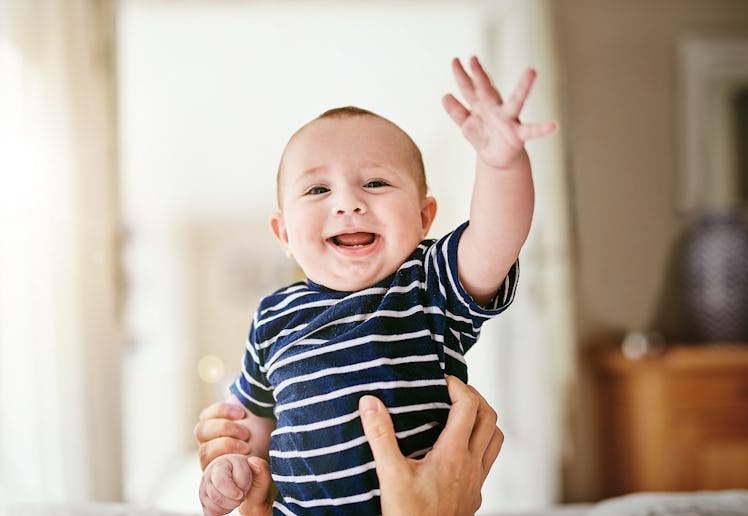When Do Babies Wave For The First Time?
The simple gesture is a language milestone.

When you say “hello” or “bye-bye” and your baby flaps their hand in response, it’s first and foremost cute. It also could count as the very beginning of them developing language. After all, a wave is a nonverbal communication skill that packs meaning. Look at me! Look at you! You’re coming my way! See you later! Yes, it’s a developmental milestone, and like all milestones it packs expectations for parents. But take it from the experts: A wave is something to simply be enjoyed. So when do babies wave? Most babies start waving by 12 months, but even if your baby doesn’t, that isn’t necessarily cause for concern.
As a general rule, you can expect your baby to purposefully wave “hi” or “bye” around 9 months of age, says Galena Rhoades, Ph.D., a professor of psychology at the University of Denver and director of the MotherWise program, a non-profit that provides support for pregnant people and new parents. “But there’s such a wide range,” Rhoades adds. It’s not uncommon to see a baby wave as early as 6 months or as late as 12 months.
Reaching this milestone indicates that a baby is making headway in their development of two skills: motor and communication. First, they need to have the dexterity to perform the waving motion. But when a baby waves, it’s more than randomly flailing their hand. It may start as merely imitating a caregiver, but waving soon transforms into meaningful communication. “It’s sign language,” Rhoades says. “We’re teaching them the words ‘bye-bye’ or ‘hello.’”
Hand-waving is different than other developmental milestones your baby will reach in the window of time between 6 months and a year, such as sitting up, standing, or walking. Those behaviors are built in. “They ought to happen automatically without much environmental input,” Rhoades says. In contrast, waving is an imitation behavior. Your baby will only learn to wave if they watch you do it first, pairing it with the phrase “hello” or “bye-bye.”
The fact that waving is an imitation behavior may account for some of the variation we see in when babies start waving. How quickly your baby learns to wave depends on how much language families use at home in general, and how much the baby watches you perform that particular gesture, Rhoades says.
Part of that variation may also depend on a baby’s physical development. Japanese scientists followed 597 full-term babies and 95 premature babies born at a very low birth weight to see when they started to wave. They found that all the full-term babies could wave bye-bye by 16 months of age, according to a study published in 2013 in the journal Pediatrics International. Even though the researchers corrected the age of preterm babies by subtracting the number of weeks they were premature, the cohort took a month longer on average to learn how to wave.
If your baby isn’t waving by the time they’re 12 months old, it might be time to contact your pediatrician — but only if they’re also missing other communication milestones typical for 12-month olds, Rhoades says. These include pointing, searching for objects that you’ve hidden, and saying single words such as “mama” and “dada,” according to the Centers for Disease Control and Prevention. “Not waving is not necessarily indicative of an issue unless it’s part of a larger pattern,” Rhoades says.
Once your baby does wave, it’s a clear sign they’re well on the way to shouting the words “hi” or “bye” when they see you or it’s time to part.
This article was originally published on